[bars]
Common Names: Derbyan Parakeet, Lord Derby’s Parakeet, Derby
Scientific Name: Psittacula derbiana
Origin: India, China
Relative Size: 20 inches
Weight: 320- 330 grams
Average Lifespan: 20-30 years
Egg Clutch: 2-4 white eggs
Incubation: 24 days
Talking Ability: Excellent
GENERAL INFORMATION ABOUT DERBYAN PARAKEET
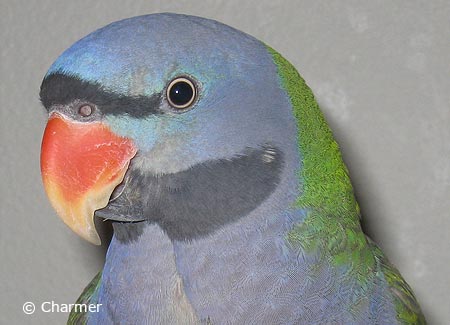
Derbyan Parakeets are dimorphic which means males and females can be identified by their colored feathers. The males and females are colorful and showcase a purple-grey head with a black chin. From the beak to the eyes, a back stripe can be seen. As the purple progresses downward towards the chest, it darkens to a plum colored pink. The wings are dark green with large yellow patches. The males have an orange beak with a tip that looks like it has been dipped in yellow. Female Derbyan Parakeets do not have this bright orange beak. Instead they have a black beak, but nonetheless, are still just as stunning.
[ads]
Juvenile Derbyan Parakeets look very similar to their mothers; however, they have black eyes and orange beaks. It’s not until the chick is mature that it will sport more vibrant colors and black eyes.
Compared to most Asiatic parrots, these birds are large. They are about the size of their cousin, the Alexandrine, or the smaller amazon bird. Most Derbyans are around 20 inches in length.
DERBYAN PARAKEETS IN THE WILD
Derbyan Parakeets are native to the remote parts of Southwestern China and the northern parts of India. These birds were once abundant, but sadly, much of that has changed due to deforestation and trapping. These birds are endemic to the Himalayan sub-alpine conifer forests and feed on berries, seeds, and shoots. These tree dwelling sentinels can be difficult to find and will make loud contact calls if danger is eminent. These parrots can be seen in large flocks ranging from 40 to 60 birds.
During the breeding season, which starts around April and can head into June, a pair will separate from the flock and look for a nesting hollow cavity and raise two to four chicks. These cavities are usually old woodpecker nests that the female has modified to house her clutch.
The pair will feed the chicks until they are weaned and can fledge from the nest around eight to nine weeks after being born.
DERBYAN PARAKEETS IN CAPTIVITY
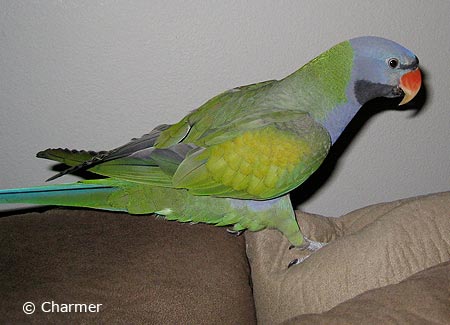
Unfortunately, these birds have been illegally sought after in China by the wealthy. Wild caught Derbyan Parakeets fetch a high price but talking Derbyans are prized ornaments and can cost as much as 3000 Chinese Yuan (roughly 1500 Us Dollars). Once a nesting site is located by a trapper, the nest cavity is cut and the babies are removed and sold into the pet trade. A grass roots effort in the hopes of trying to repopulate them in the wild has been ongoing by Derbyan enthusiasts and zoos throughout. These enthusiasts are continuing to record the breeding habits of these birds.
DERBYAN PARAKEETS AS PETS
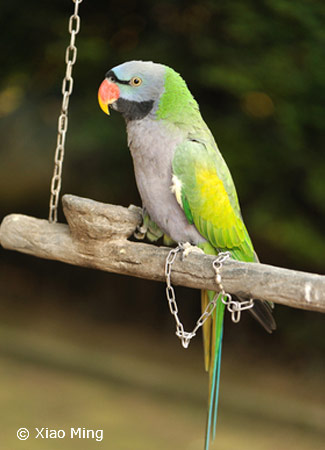
Derbyan Parakeets make wonderful pets. These parrots are very smart and enjoy spending a great deal of time with their owners. They are not too cuddly but make up for this with sheer intelligence. These birds have tightly packed feathers and love to be petted alongside their necks. Most owners can easily enjoy watching television, reading, or walking with their bird perched on their shoulder.
These birds need plenty of toys to keep them busy during the day. Like the Alexandrine Parrot, they love to chew. For this reason, it would not be wise to let the parrot wander around unsupervised around wooden cabinets, curtains, furniture, or expensive items will easily become damaged.
Having hand toys made of hard wood, rope, and leather is ideal as anything less will be destroyed in a matter of minutes. Toys that are placed inside the cage should be rotated weekly to avoid the parakeet from becoming bored.
These parrots need a play stand to hang around when not inside the cage. All Derbyans are very curious by nature and will most likely wander off the stand. The owner should simply continue to place the bird back up on the stand until the bird eventually learns to stay put.
These parrots are gifted at talking. Both sexes are able to talk, but it appears that the males are more gifted at talking. Like all Asiatic parrots that can talk, Derbyans too go through a babbling stage and it’s the owner’s job to encourage this behavior in order to develop the bird’s vocabulary. These parrots have clear and loud voices. Teaching your Derbyan to talk will greatly replace the loud annoying contact calls with talking.
It should be noted that not every parrot will talk. Many owners make the mistake of purchasing a Derbyan simply because it is believed it will be a great talker. When the bird does not meet the owner’s expectations, some owners tend to ignore the bird and this can produce devastating results for the parrot.
Before purchasing a baby Derbyan, the owner should know these parrots are moderately noisy. Though they are not as noisy as a cockatoo bird, they can produce very loud sounds. Contact calls can be expected early in the morning, at noon, and at night.
BREEDING DERBYAN PARAKEETS
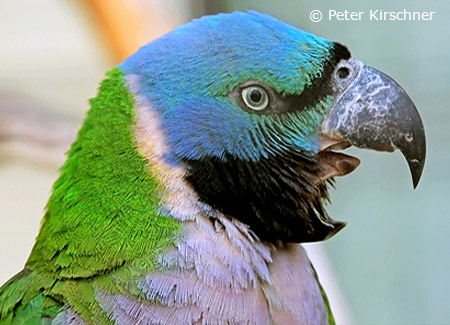
Breeding Derbyans is much more complicated than working with the average Asiatic parrots. These larger Derbyan Asiatic parrots need a great deal of privacy when breeding. Though these parrots reach maturity around three years of age, most breeders find mature birds of five years or more to be best suited for breeding.
These parrots prefer a deep box placed in a secure location. Placing a few boxes inside the aviary is ideal as this will give the pair a choice for the right spot to nest. Once the nest has been chosen, the female will spend a great deal of time inside the box before laying her eggs. It’s important to note that having metal boxes or wooden ones with metal plates attached to the outer sides is a great idea as some females will chew right through the bottom.
After the pair has mated, eggs can be expected within two weeks. The female Derbyan will produce between two and four eggs. She will incubate the eggs for approximately 24 days. Once the chicks hatch, the mother will eat the shell or push the shells to the side of the nesting box.
If this is the first time the Derbyans have nested and successfully hatched their chicks, it is a good idea to not pull the babies and let the mother raise her young to adulthood.
If the babies are to be pulled for hand feeding, the oldest baby should be at least 15 days old before removing. Once a chick is removed from the nesting box, it’s important that the whole clutch be also separated from the nest because the removal of one chick sometimes causes the mother to abandon her brood.
SELECTING THE RIGHT CAGE FOR YOUR DERBYAN PARAKEET
Finding the right cage for a pet Derbyan is important as the parrot will spend many hours inside the cage. The cage should be large enough to allow the parrot to climb around, swing from its toys, and hang upside down without touching the cage sides. The best cages are those that have been powder coated and have thicker bars. The spacing between the bars should be about a half inch apart to avoid the parrot from getting its head stuck.
Because these parrots are known for their chewing behavior, the owner should ensure the perches inside the cage are made of hardwood. Soft wooden perches will easily become chew toys and will need to be replaced.
Food and water bowls should never be placed below the perches due the parrots droppings; therefore causing contamination. Many owners can buy ceramic bowls that fit into circular hooks and can suspend easily from the cage walls. Toys inside the cage can become dirty if not properly placed so the owner should take great care in arranging them inside the cage.
The bottom of the cage should have a grill with a tray that can easily slide out. This bottom grill ensures the parrot cannot access food that has dropped to the floor nor have contact with its droppings.
FEEDING YOUR DERBYAN PARROT
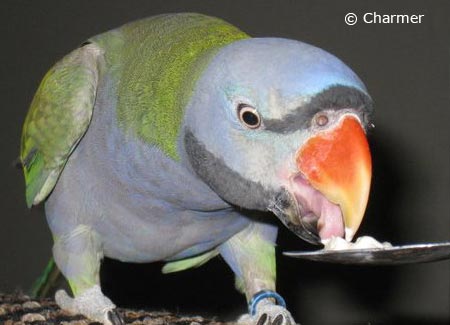
Feeding these parrots a healthy diet is essential. In the wild they eat a variety of foods and it should be no different when kept in captivity as pets. Most owners will feed their pet Derbyans a diet of seeds, pellets, fresh fruits, and vegetables.
These parrots are not picky and will relish anything placed into their cage. Some owners prepare fruit kabobs for their parrots daily. For example, fresh kiwi, mango, and apples interlaced with spinach or broccoli make great kabobs. Cooked beans can be given along with lentils and corn. It’s important that the owner be creative when feeding their bird as these parrots like a variety of foods with colors and tastes.
There are many pelleted diets on the market, but like seeds, this should not be the only food given to your bird. Too much of anything is a bad thing and could cause complications down the road.
Foods to never give your parrot are chocolate, avocado, or alcohol. These items are toxic and can lead to death for your pet Derbyan.
If your pet Derbyan is fed properly, the owners can expect their birds to live between 20 and 30 years.
[ads]
